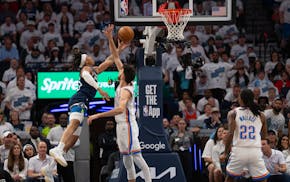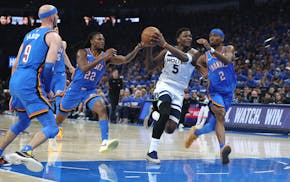A group of Minnesota high schoolers competed in a USA Baseball national tournament last summer against teams from the southwestern part of the country.
Kids from that talent-rich geographical quadrant have the good fortune of playing baseball outdoors year-round. Minnesota kids throw snowballs outside in the winter.
The tundra teens captured fourth place out of more than 100 teams, losing a pair of one-run games in the semifinals and bronze medal game. They opened some eyes.
"They basically were like, I didn't know they play baseball up in Minnesota," said Max Arlich, a pitcher on that MASH club team and standout at East Ridge High.
Despite weather obstacles, Minnesota baseball is healthy and prosperous, especially on the pitching side.
A handful of pitchers who participated in that national event will be on display at the state tournament starting Thursday. In fact, nearly a dozen pitchers competing in the tournament have signed or committed to play for high major Division I college programs. The list that includes Texas A&M, Ole Miss, Alabama, Tennessee, North Carolina, TCU, Iowa, Purdue, Indiana and the Gophers.
That doesn't account for standout hurlers whose teams didn't advance to state or underclassmen who are on track to play major college baseball.
"The last couple of years there has been a lot of pretty darn good arms that have been coming through the state," said Rockford, Minn., coach Cody Hallahan, who has one of those darn good arms in junior Will Haas, a Tennessee commit.
Those involved in Minnesota prep baseball call this pitching bonanza a burgeoning trend more than a blip of exceptional talent. Factors include year-round training, better exposure for Minnesota talent thanks to social media and scouting services, and more kids specializing in baseball.
Minnetonka coach Paul Twenge traces one pivot point to a decade ago when Coon Rapids pitcher Logan Shore became an instant star at the University of Florida. His success at a high-profile program "really broke the ice for most recent pitchers," Twenge said.
"What schools are finding out is," Twenge said, "pitchers that are here don't have all the mileage on their arms. If you come to see these young kids, you really see what their ceiling possibly could be."
No factor has contributed more to pitching development than an explosion in club baseball. Kids receive specialized training and more exposure by competing in showcases and tournaments across the country.
Arlich, a Texas A&M signee who pitched a complete game shutout in the Class 4A championship game last season, exemplifies the role of clubs in a pitcher's development.
He started focusing on pitching year-round as a freshman. He used winter months to build strength in the weight room and work on his craft off the field. Access to MASH club facilities and coaches mitigated the downside of not being able to train outside.
"Pitching is more about development," Arlich said. "You're forced to have to develop in the winter months. You can work on your mechanics and work on small things for months at a time because it's snowing out."
Former Twins third baseman Corey Koskie helped coach that MASH team that finished fourth at nationals. His son Caleb, a standout pitcher for Benilde-St. Margaret's who has signed with Indiana, was a member. Koskie has seen Minnesota's national profile grow through the lens of being a dad and coach to young players.
"I think this is the accumulation of Minnesota baseball players who at age 14 years old are now committing to baseball," Koskie said. "Before, without the club programs, you couldn't commit to play baseball all year."
Some argue that Minnesota has long featured elite pitching, but that the prevalence of social media has altered the perception of Minnesota baseball.
East Ridge coach Brian Sprout has three pitchers bound for SEC schools on his roster this season. Sprout recalls trying in vain to promote his players years ago to college recruiters before X (formerly Twitter) became in vogue.
As a junior, East Ridge's Jake Reigert posted a video of his fastball clocked at 92 mph.
"I'm not kidding," Sprout said, "within about three minutes I had a coach calling me about him."
Reigert signed with Ole Miss.
Baseball's fascination with metrics has opened doors in conjunction with social media. Scouting services provide both exposure and new technology that serve as a megaphone for prospects. The velocity and spin rates craze in Major League Baseball has trickled to high school. High schoolers now have access to that information and can share publicly.
"Everybody is chasing the numbers that gets someone to look at you," Sprout said. "That's happening at the 13/14U level just as much as it is at the high school level."
Rockford's Haas has amassed 141 strikeouts in 70⅔ innings this season with a fastball clocked at 94 mph. He views the crop of high-end pitching prospects headed for blue-blood college programs as proof that outsiders see Minnesota as more than "just a hockey and basketball state," he said. "People are starting to take baseball more seriously."
The baseball season might be short here, but that doesn't mean kids are taking a break while waiting for the snow to melt.

Scoggins: Finch's next challenge is to unleash the Wolves' youngsters

Scoggins: Timberwolves learn just how far behind they are

Scoggins: Chet Holmgren is in the right place at the right time

Chet Holmgren remains a basketball unicorn, a status forged in Minnesota and on display in the NBA


